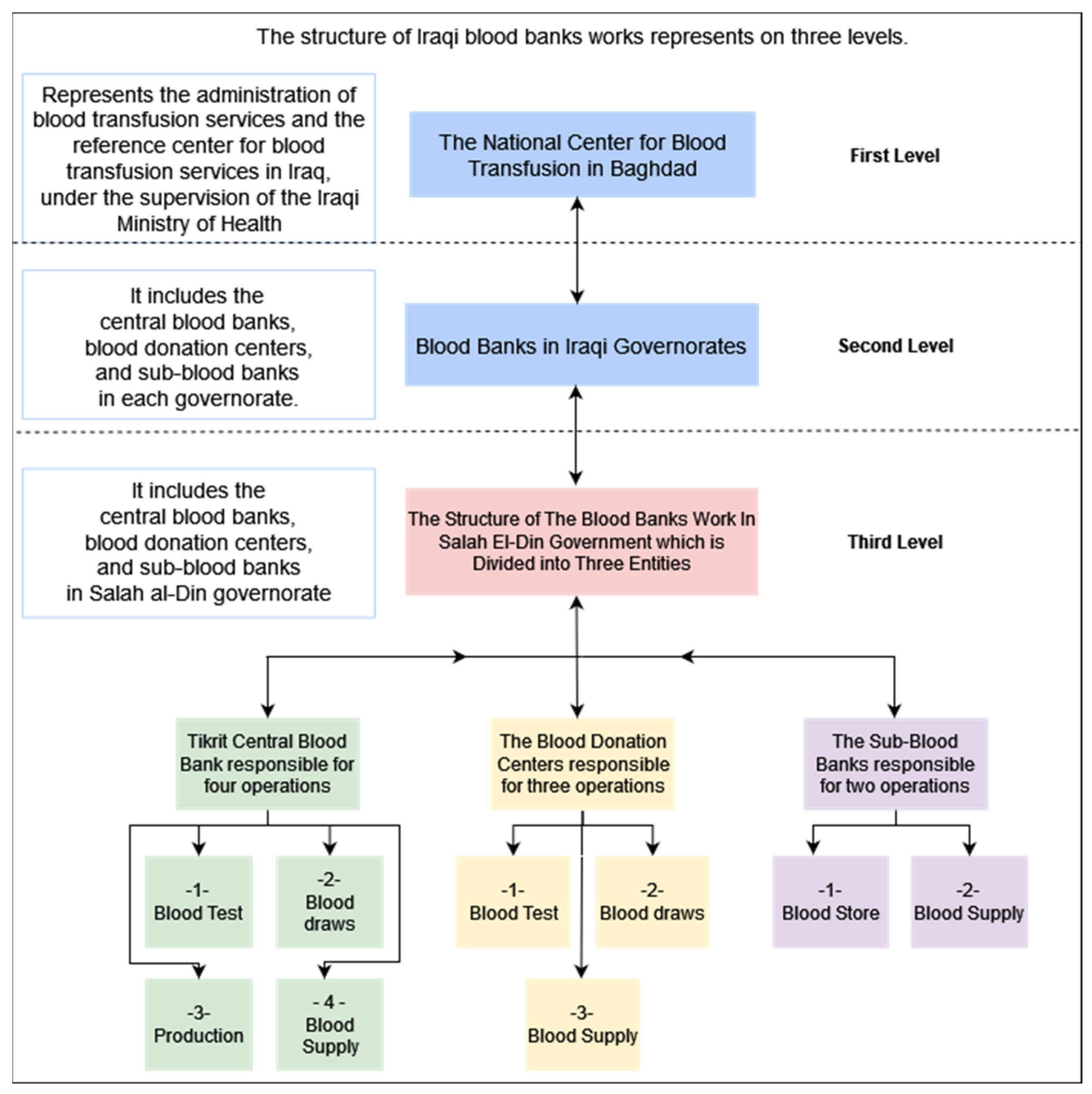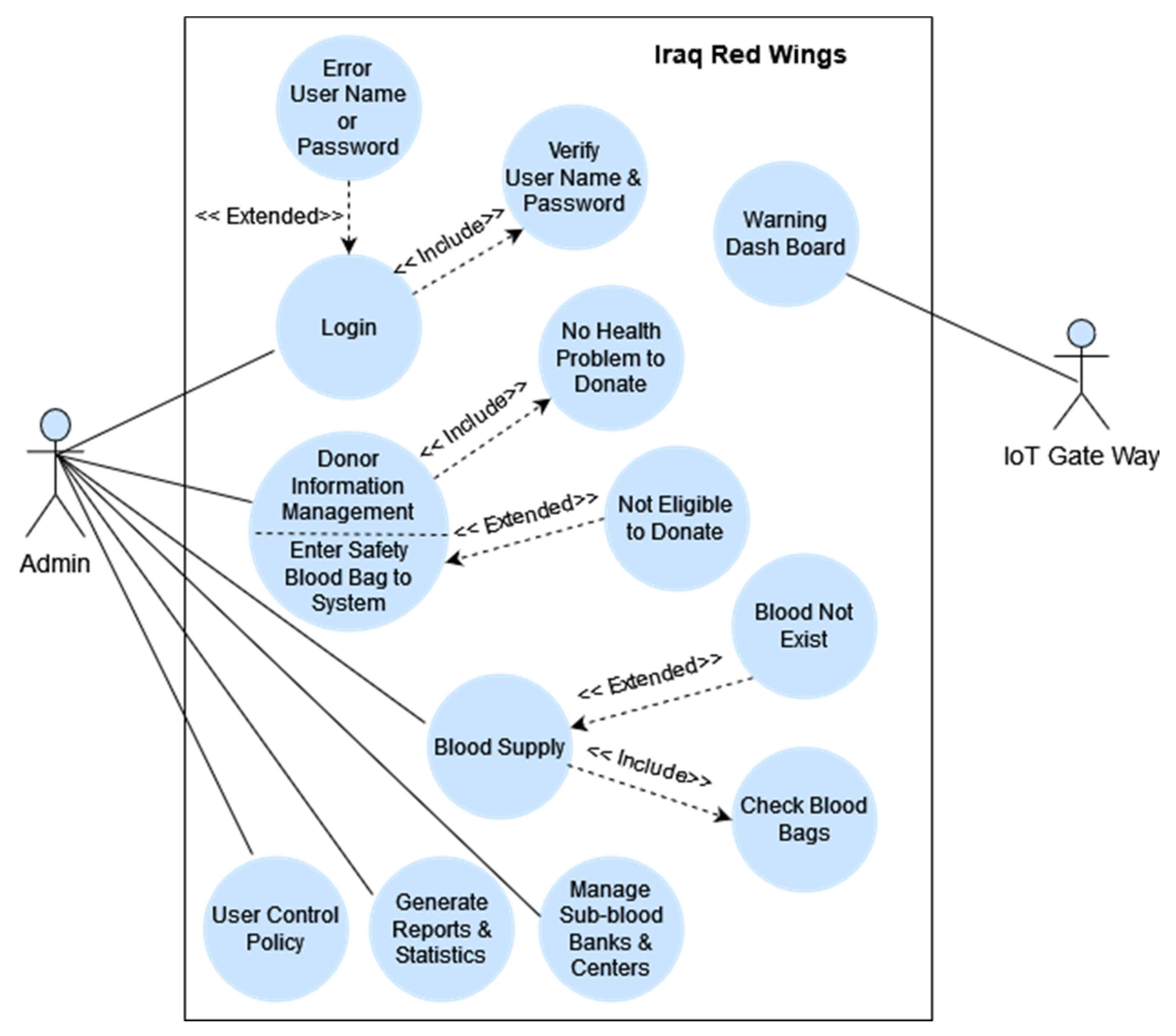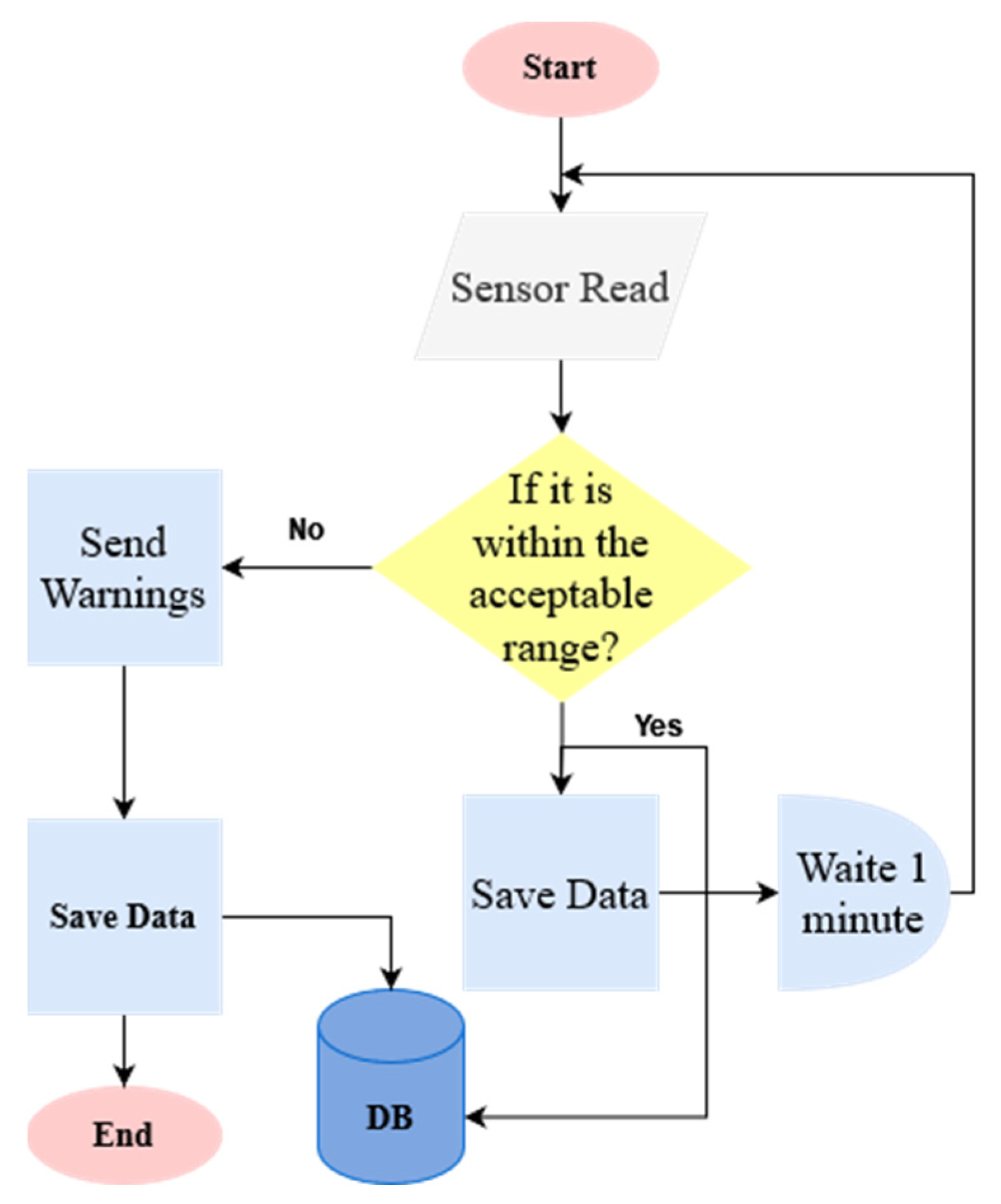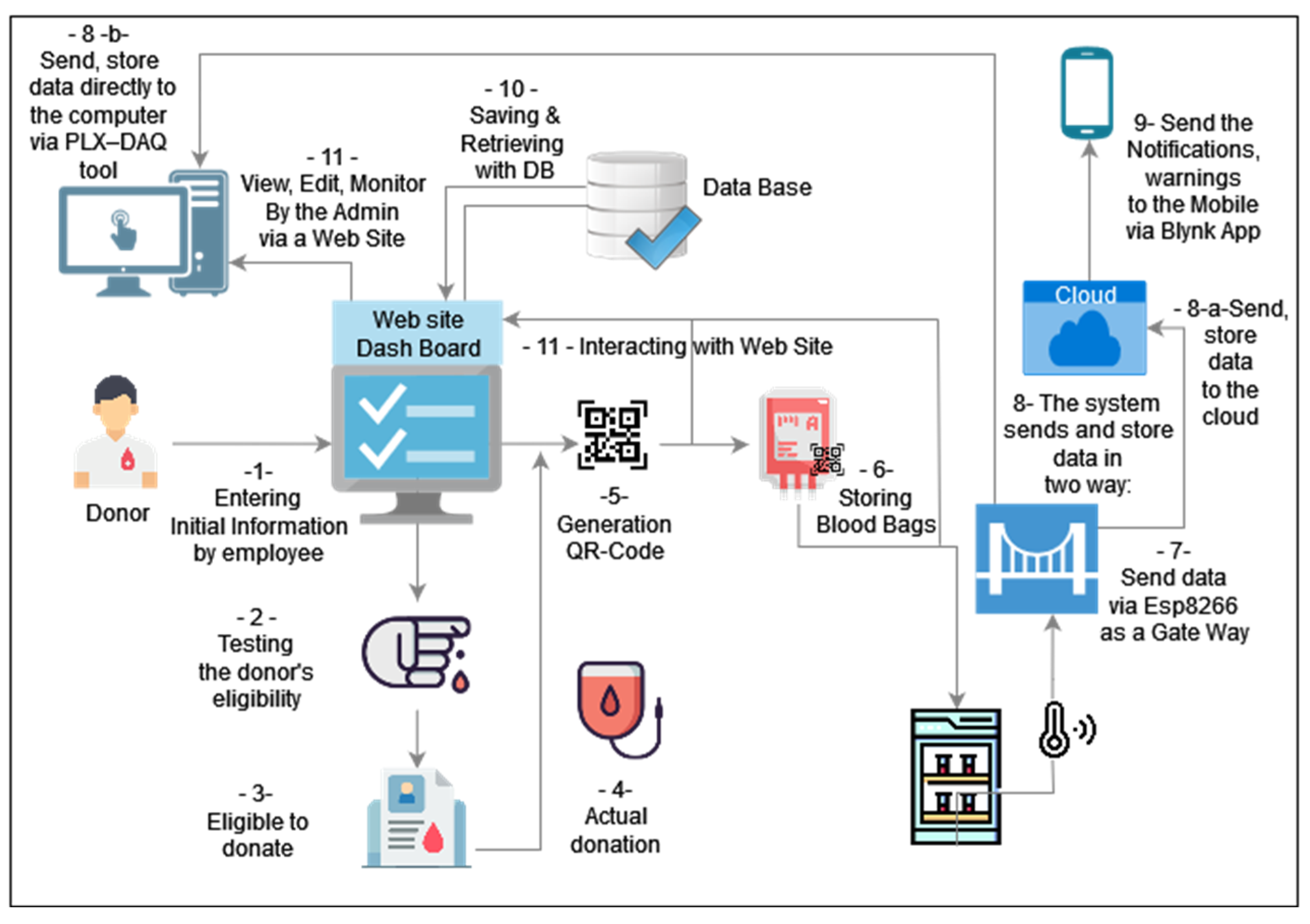1. Introduction
Annually, more than one million units of blood are donated worldwide. Even at this rate, the need for blood is still severe and far from being met [
1]. It is estimated that about 80% of the world’s population has access to only 20% of the world’s blood supply [
2]. Blood is a necessary resource for special treatments and emergency surgeries following natural disasters, accidents, armed conflicts, etc. The blood bank system (BBS) is a vital and rare resource in health care systems that must be properly, accurately, and directly managed [
3,
4,
5,
6]. Good management can help the wounded and patients with life-threatening diseases, reducing the risk of death. The significance of the blood bank system is emphasized in emergencies, disasters, and wars [
7]. It is also responsible for providing a range of services on an ongoing basis, such as the process of donating blood, its preservation, and its transfusion, and for providing reserves of blood and its products [
8].
According to the World Health Organization (WHO), the availability and safe use of blood and blood components vary between developed countries and developing countries [
9]. There are significant limitations in health care systems in developing countries [
2], such as those in the Eastern Mediterranean Region (EMR), where blood services face considerable problems related to the availability of blood and the assurance of its quality and safety. Unfortunately, despite the benefits of new technologies which improve and speed up the work of the BBS, these systems are not updated, especially in developing countries. This has created many challenges, barriers, and limits, such as reliance on human intervention and problems in managing donor information, periodic reports, and matching blood types for transfusions to patients [
10,
11]. Moreover, the lack of coherence in the database shared by blood donation centers leads to a lack of the most recent information, and the patient is unable to obtain the necessary and matching amount of blood on time [
12]. Moreover, the irregularity of the electricity supply in developing countries mainly affects the health sector [
13]. Unstable access to electricity results in the storage of blood outside WHO-recommended temperature limits.
Based on blood safety and availability, according to the WHO Fact Sheets, the blood collection rate is less than 10 per 1000 people in 6 of 21 MENA regions, including Iraq. In low-income countries, children under 5 years account for up to 54% of all transfusions, while patients over 60 years account for up to 76% of all transfusions in high-income countries. The average blood donation rate is more than nine times greater in high-income countries than in low-income countries [
11]. Iraq is country that has suffered from wars, terrorist operations, and combative spread, and it is considered an ongoing conflict zone. This has caused the deterioration of the infrastructure of service institutions, especially health care institutions, such as hospitals, medical centers, and blood banks, as well as the instability of the electricity supply in Iraq and other war-torn countries [
14].
With the rapid development and advances in technology, health care procedure management and disaster management are the most popular majors [
12]. According to the literature, using new and different technologies in the health care field is widespread because it provides personalized and high-quality services on time [
15]. Because of the perishable nature of blood products, blood management is considered a daunting task in modern medicine [
16]. The improvement in the health care field has possible via recent technological developments, such as the application of many emerging and innovative computer technologies, for example, mobile Internet, smart transportation, data mining, machine learning, block chain, GPS Global, and the IoT, with excellent results [
12,
17]. On the other hand, issues that must be considered relating to these technologies are big data, data security, competitive technologies, and medical technology, because all have contributed to rising health care costs [
17]. Security is the biggest challenge for the IoT, along with accuracy issues and the price [
18,
19]. Scalability is one of block chain’s notable flaws; it is not indestructible and can increase complexity [
20]. Health care services are not equally distributed between rural and urban areas [
21]. Walls and other objects can obstruct global positioning systems (GPS), and regular GPS precision is limited to 3 m. GPS services access users’ private information, so privacy and anonymization concerns are major issues that must be addressed [
22].
Various health care areas can apply the Internet of Things and Web apps to address multiple problems and challenges [
12]. The IoT presents a vision of intelligence by allowing communication between devices and humans via the Internet [
23,
24]. It provides availability through remote monitoring of patients, the recording of the status of products, and the tracking of medical equipment, such as blood bags, or smart blood group recognition labels for donors and patients in blood banks, hospitals, or medical centers [
10,
12]. The use of sensors, self-coordination, and simulation can aid in prediction. The fast response of the sensors may save lives, limit damage, and generally reduce the level of danger, especially in natural disasters [
25]. For example, DHT-11 is the temperature and humidity sensor that was used in study [
26] to monitor the temperature of blood bags within an acceptable limit.
All that is needed is the development of health care software and its integration with different technologies, such as using IoT technics based on mobile or Web applications.
In ref. [
27], the researchers introduced an application that connects the givers and the blood requesters who live in Nineveh province, Iraq. The blood requester can search and directly contact donors without any third-party involvement. The Google Firebase Real-Time database and one WebSocket two-way channel were used, and data were stored a JavaScript object notation (JSON) file. Another study in [
28] showed how important it is to use model inventories, both probabilistic and non-probabilistic, to help blood banks to find the optimal quantity of blood and product required while trying to make the total cost lower. Additionally, some researchers in [
29] discussed solving the problem of blood group transfusion in the National Bank of Iraq using multi-models consisting of a transfusion model, particle swarm optimization algorithm, and analytic hierarchy process to find the best transfusion from the donors to the persons who need it. However, none of these studies designed or developed a blood bank system to improve the traditional paperwork system.
The Central Blood Bank of Salah El-Din in Iraq is responsible for collecting blood in the city and providing it to patients in hospitals, banks, and sub-centers. It is a traditional, paperwork-based system that is faced with human mistakes, delays in the retrieval of information, and the absence of a central database of donors’ records, which may cause confusion or real obstacles owing to the lack of an automated computer system or an effective electronic mechanism for communication between the central bank and branch centers. Such problems endanger patients’ lives and may lead to death, especially in critical times. The main objectives of this study are to:
Study and analyze the existing system (the Central Blood Bank of Salah ad-Din);
Design and implement the proposed system Iraq Red Wings (IRW) using Web technology and (IoT) technics;
Test and evaluate the proposed system.
The contributions of this paper can be summarized as follows:
A detailed and applicable framework in the field of BBS systems that contributes to developing this field in developing countries;
A proposed solution to the instability of the electricity supply in developing countries that monitors the temperature of blood refrigerators in real time and stores a local copy;
An analysis and assessment of the requirements of the Iraqi blood bank structure;
The design, development, and implementation of a BBMS for a city in Iraq with a total area of 23,398 km
2 and a population of 1,595,235 that has suffered from terrorism and wars for more than 40 years [
30];
An evaluation of the system during the parallel operation period, which lasted one month, by 22 experts in the field of blood banking.
The significance of the proposed system is manifested in its ability to manage and organize the blood bank without human interaction, avoid errors, maintain a high level of accuracy and reliability, monitor the blood inventory for hazards, such as unsuitable temperatures or being out of date, etc., and improve the functionality in storing, retrieving, and analyzing information, which will be helpful, especially in emergencies.
This article is divided into sections: (1) Introduction, which contains an overview of the new technology that affects the health care sector; (2) Related Works, which discusses traditional vs. automated systems, IoT-technology-based systems, and the gap study; (3) Methodology, comprising the analysis and design of the proposed system; (4) The Implementation of the Proposed System in two parts: the Web application part and the IoT technics part; (5) System Testing and Evaluation, which contains the functionality testing and temperature sensor testing; and, finally, (6) Conclusion.
4. The Implementation of the Proposed System
This study offered a practical, efficient approach based on a Web app combined with IoT techniques to facilitate blood bank work. It was designed using a MySQL database, the PHP programming language, and a QR code storage technique to provide simple interfaces which avoid complicated steps in entering and collecting the data (donors, hospitals, blood banks) and fulfilling and securing blood bag management. It also uses a temperature sensor (DHT-11) to monitor the blood bag temperature. In addition, a proper mobile application, the Blynk app, was used because it has a user-friendly interface and can work efficiently with ESP8266 for either monitoring or controlling via mobile phone [
53]. The process of recording donor’s data and blood bag information was made easier with the Web pages and QR code reader and ensured the efficiency of the save process. The Central Blood Bank of Tikrit was the actual case study used to build this system.
Figure 10 shows the overview of the entire proposed system.
To illustrate how the proposed system works, it was divided into two parts.
4.1. The Web Application Section
A login process is undertaken by the admin (the manager or medical employee) to enter the donor’s initial data (name, blood type, etc.) in the reception unit;
A clinical test of the donor’s blood sample is conducted to ensure that the blood is eligible for donation (free from transitional blood diseases);
If the blood test result is positive, the donor is not qualified to donate, and their information is recorded in the database. If the blood test result is negative, the donor can donate and complete the rest of the steps;
After the actual donation, the donor completes the registration process, including all the information required by the receptionist employee;
A donor QR code is generated in the form of a label to be affixed to the blood bag of that donor;
The QR code label is affixed to the blood bag.
The reading of the QR code label on the blood bag was carried out by the code reader for inclusion in the database and then the blood bag was kept in the refrigerator. The saving of the blood bag information via QR code was an automated process (more accurate and free from human error, obtaining accurate statistics and reports at any time). When the blood bag was removed to provide blood to the person in need, the code reader performed the opposite process.
4.2. IoT Section for Temperature and Power Failure Monitoring
Using Internet of Things technologies, the blood bag storage refrigerators (eight refrigerators for the four blood groups with factors of RH+, RH−) were connected to eight temperature sensors (DHT-11) for maintaining and monitoring the blood bag temperature 24/7 within the acceptable temperature range (4 to 6 °C).
The acceptable temperature limit for storage depended on the product type (whole blood, red blood cells, platelets, plasma, cryoprecipitate, antibodies, white blood cells, and blood substitutes). In this study, the whole blood product type was chosen to implement the test.
- 7.
The temperature sensor reads every ten seconds, about six readings per minute, and sends these values continuously via the ESP8266 microcontroller as a gateway using Internet technology;
- 8.
The system sends the data (temperature values) via ESP8266 in two ways:
- 8-a
For local storing, the data are sent to the computer device by the PLX-DAQ tool to view and store the values via Excel sheets, so the administrator can view them at any time;
- 8-b
For online storing, the data are sent to and stored in the cloud in real time;
- 9.
These data are read with the Blynk application, then, the notifications (warning messages) are sent to the mobile phone via email at any time and from any place.
The temperature value ranges specified by the code to send warning messages are:
- -
The ideal temperature value range is 4 to 6 °C;
- -
The acceptable temperature value range is 2 to 8 °C;
- -
Outside of the acceptable temperature value range is lower than 2 °C or higher than 8 °C.
Temperature values (data) outside the assigned range predict problems such as the following: electrical faults, refrigerator malfunctions, the refrigerator door not closing correctly, etc.; the values are then sent to the cloud, and a warning is sent by the Blynk app to the administrator via email on their mobile phone. In addition, these values are sent to the computer device (for the Excel sheet) via PLX-DAQ tool and stored locally in the database. If 15 min pass and the issue is not solved, the system resends the alert several times more until the problem is solved;
- 10.
All data are sent, saved, and retrieved via the database of the proposed system;
- 11.
The admin can interact with all data through the Web app dashboard.
Figure 11 below shows the connection of the temperature sensor with the refrigerator that supplies the O+ blood group. The link could be one sensor unit connected with one refrigerator or eight sensor units connected with eight refrigerators.
Figure 12a,b shows how the monitoring process of the blood bag refrigerators was achieved via the Blynk app. Blynk was used due to the ease of development of the smartphone application, so it was used for model setup and configuration and real-time monitoring [
54].
In (a), the temperature degree within an acceptable range (5 °C) is shown, whereas (b) shows the warning message received on the mobile phone if the blood temperature is outside of the ideal or acceptable ranges.
To ensure that the IoT devices worked during power failure, a backup Panasonic NCR18650B 3.6 V lithium-ion battery was used. It is a rechargeable battery with a high energy density, long stable power, and long run time and is ideal for portable devices. Both the power supply and the backup power supply were left outside the blood cooling device.

























